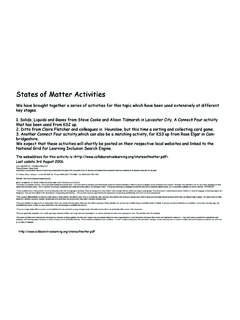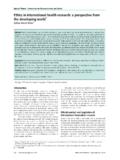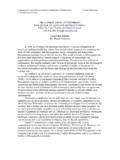Transcription of Learning to talk, talking to learn by Robin Alexander
1 Learning to talk, talking to learn by Robin Alexander From the now substantial body of research on language, Learning and teaching there are several strands with which we should be particularly concerned. The first and foremost is psychological. Language and thought are intimately related, and the extent and manner of children's cognitive development depend to a considerable degree on the forms and contexts of language which they have encountered and used. When children learn language,' argues Michael Halliday, they are not simply engaging in one type of Learning among many; rather, they are Learning the foundations of Learning itself.'. But whereas teaching during the 1960s and 1970s was strongly influenced by the idea - attributed, perhaps unfairly, to Piaget - of the child as a lone scientist' who develops cognitively by interacting with stimulating materials, from the 1980s this approach was increasingly challenged by the Vygotskian view that the child's cognitive development also requires it to engage, through the medium of spoken language, with adults, other children and the wider culture.
2 Development, then, is a social process as well as a biological one. Children construct meaning not only from the interplay of what they newly encounter and what they already know, but also from interaction with others. In turn, this interaction is critical not just for children's understanding of the kind of knowledge with which schools deal - mathematics, science and so on - but also for the development of their very identity, their sense of self and worth. The others' with whom children interact assume a critical role in the process of cognitive scaffolding', a term first coined by Wood, Bruner and Ross in the 1970s in the context of mother-child interaction and now more commonly applied to what goes on - or does not - in classrooms. This is the use of carefully structured interventions to bridge what Vygotsky called the zone of potential (or, in most translations, proximal') development', or the gap between the child's existing knowledge and ways of solving problems unaided and the understanding which can be attained only with the guidance of the teacher or a more capable peer'.
3 In other words, Learning and development are not synonymous, as in the heyday of progressivism they tended to be regarded. It is true that children learn regardless of the intentions of their parents, carers or teachers, simply by being acutely alive to what is going on around them. But Learning to a specific cultural purpose requires intervention and support by others. Emphasising the critical role of interaction in this process, Vygotsky even went as far as to argue that the true direction of the development of thinking is not from the individual to the social, but from the social to the individual.'. While it is clear that this approach challenges the once popular view of the teacher as a hands-off facilitator', it is important to stress that it does not herald a return to the traditional model of teaching as mere telling or transmitting.
4 Where both of the earlier models implied activity on one side of the teacher-pupil relationship but passivity on the other - active pupils and passive teachers in one, passive pupils and active teachers in the other - the new approach demands both pupil engagement and teacher intervention. And the principal means by which pupils actively engage and teachers constructively intervene is through talk. Such talk, as Daniels emphasises in his recent work on activity theory, must not be regarded as mere interaction', narrowly conceived and bounded by the immediacy of the Learning task in hand. Classroom talk mediates not just teaching and Learning but also the wider culture. As Bruner again argues, several lines of research - on intersubjectivity, on the nature of the human mind, on metacognition and on collaborative Learning - all converge on the principle that children must think for themselves before they truly know and understand, and that teaching must provide them with those linguistic opportunities and encounters which will enable them to do so.
5 These ideas have been given a further boost by neuroscientific research . It is now understood that talk is necessary not just for Learning but also for the building of the brain itself as a physical organism, thereby expanding its power. If, as has long been known, the first three years of life are critical to subsequent development, it is now recognised that the period between 3/4 and 10/11 - the primary phase of schooling, more or less - is one in which the brain in effect restructures itself, building cells, making new fibre connections between cells, pruning old ones, developing the capacity for Learning , memory, emotional response and language, all on a scale which decreases markedly thereafter. Between birth and adolescence, brain metabolism is 150 per cent of its adult level, and synaptogenesis (the growth of brain connections) causes the brain's volume to quadruple.
6 Talk actively and vigorously fuels these processes. Moreover, the periods between birth and 3/4 and between 3/4 and 10/11 are those when the brain's capacity to acquire language is strongest. Apart from underlining the imperative of talk in the home, and in preschool and primary education, this finding raises a separate question about the way in Britain the Learning of foreign languages is postponed until the secondary stage of schooling. By then it may actually be more difficult, not less, to learn a new language. Having said that, brain research also tends to dent the claim that there are all-or- nothing critical periods for Learning . Though some kinds of Learning are more effective during the early years, synaptogenesis can occur at any period of life and humans retain the capacity to learn , and to learn extensively and in complex domains, throughout their lives.
7 Neuroscience also supports the Vygotskian critique of teaching as mere developmental facilitation, discussed above. In some domains perceptual, certainly, and to a degree social too - implicit Learning clearly takes place, but higher-order cognitive activities of the kind that characterise formal schooling require both conscious effort and direct intervention. As Goswa- mi notes, responding sceptically to Blakemore and Frith's views on Learning without awareness': Children spend much of their day in classrooms, [but] their brains do not automatically notice'. how to read or do sums. These skills must be directly taught. It seems much more likely that the power of Learning without awareness is relevant to education via social cognition. These insights from emerging neuroscientific research are doubly helpful: first in confirming the importance of teaching as intervention rather than mere facilitation; secondly, as an endorsement of teaching which capitalises on the collective and interactive environment which classrooms offer.
8 The boundaries may not be precisely delineated: indeed, that's the point, for it seems evident that it is advantageous to the learner if we see implicit social Learning and the explicit teaching of higher-order concepts as linked and mutually-supportive processes. In the account of dialogic teaching which we develop in this publication, the dynamics of talk matter no less than its content, while social and cognitive purposes go hand in hand. The second strand of research is sociological - or, more specifically, sociolinguistic, for it is concerned with the kinds of language and language environments which classrooms actually provide, as opposed to what the psychological and neuroscientific evidence suggests they ought to provide. Ever since, during the 1960s, Douglas Barnes explored patterns of teacher-pupil communication in secondary school and Philip Jackson charted the consequences for children of the unequal relationship of teacher and taught, researchers have been sensitive to the risk that, if we are not careful, classrooms may be places where teachers rather than children do most of the talking ; where supposedly open questions are really closed; where instead of thinking through a problem children devote their energies to trying to spot the one 'correct' answer.
9 And where the supposed equality of discussion is subverted by what Tony Edwards calls the 'unequal communicative rights' of a kind of talk which remains stubbornly unlike the talk which takes place anywhere else. Clearly, if classroom talk is to make a meaningful contribution to children's Learning and understanding, it must move beyond the acting out of such cognitively restricting rituals. The third strand of enquiry links to the first two. Following the ORACLE observational research of Galton and Simon during the 1970s and later studies by Mortimore, Alexander , Bennett, Wragg, Pollard and others, we have built up an increasingly comprehensive picture of classroom life, especially in primary schools." Among the features on the debit side which seem particularly resistant to change are the relative scarcity of talk which really challenges children to think for themselves, and especially the low level of cognitive demand in many classroom questions; the continuing prevalence of questions which remain closed despite our claims to be interested in fostering more open forms of enquiry; the habitual and perhaps unthinking use of bland, all-purpose praise rather than feedback of a kind which diagnoses and informs; the seeming paradox of children working everywhere in groups but rarely as groups.
10 The rarity of autonomous pupil-led discussion and problem-solving; and the tendency of classrooms to be places of risk and ambiguity rather than security and untouched by the 1980s revolutions in curriculum and assessment. Later studies from Newcastle, Cambridge and Reading universities showed that though the introduction of the UK government's flagship National Literacy and Numeracy Strategies in 1998 and 1999 may have transformed the content and organisation of literacy and numeracy lessons in many English primary schools, they appear to have had much less impact on the deeper layers of classroom talk - especially those habits of questioning and feedback referred to earlier. Thus, to quote - at some length, but the study merits this - from the investigation by Smith, Hardman, Wall and Mroz into the pedagogical impact of the National Literacy and Numeracy strategies: The findings suggest that traditional patterns of whole class interaction have not been dramatically transformed by the Strategies.















